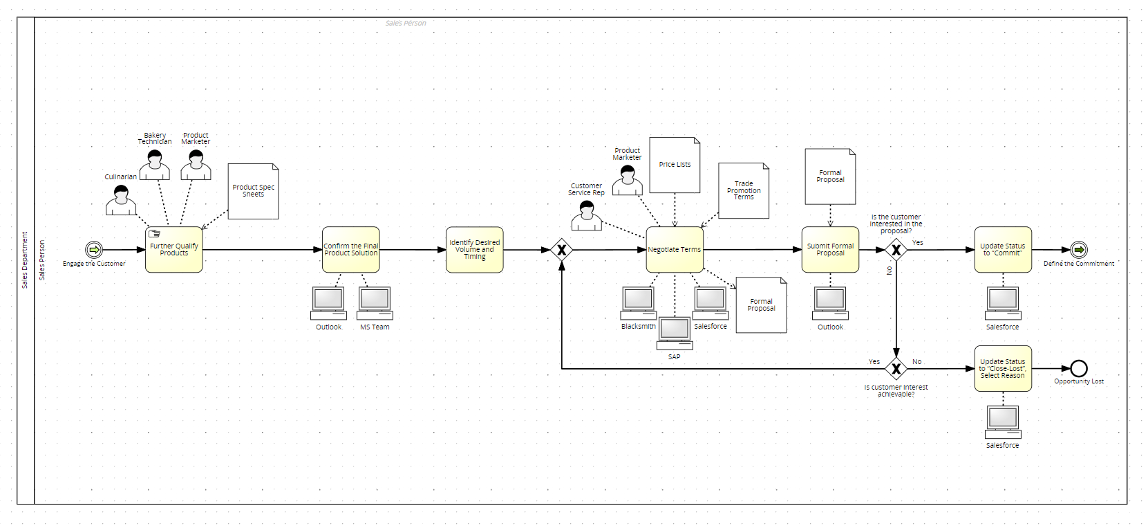Summary
A food manufacturing organization needed a structured approach to standardize their existing sales and financial process models as most were kept in multiple formats and systems leading to confusion and knowledge diffusion. Scheer Americas, with input from the Finance and Sales teams, was able to quickly respond by enabling their journey using the Scheer Value-driven Business Process Management methodology.
This initiative was driven to establish a methodology by using the Finance Teams organizational structure and accompanying As-Is Processes to effectively standardize process capture for improvement. To accomplish this goal, a Process Repository was required, to host as well as organize the company's existing financial organizational structure. In parallel a BPM Playbook was created to define the modelling standards and guidelines for the organization to use going forward in expanding their process improvement journey. After the initial endeavor was concluded, the company’s leadership teams saw the value add from the structured implementation and added additional business areas, like Sales to include more organizational process information. With an already defined approach and clear project scope Scheer rapidly implemented the Sales processes into the existing repository and hosted training to foster knowledge transfer to conduct future projects internally.
Organization Background
The organization is a reputable and established leader in the food manufacturing industry. With a rich history spanning over 75 years, the company strives to continue adapting to the market as it adopts a BPM-Discipline. The company holds a deep commitment to ensuring customer satisfaction while having organizational goals to drive innovation and efficiency.The company offers a comprehensive range of food products such as cakes, breads, pizzas, and additional dessert items. The organization is looking to utilize BPM to drive innovation and establish a process culture for future digital transformations.
Business Challenges and Opportunities
The main challenge within the project was an undefined goal for the usage of the process models and undefined BPM standards which had not finalized prior to the initiative’s start. The organization had multiple ongoing projects with several invested stakeholders that were in flux from which the processes models Scheer was given to standardize were initially documented. The collaboration between all parties was not aligned from the beginning of the initial initiative and therefore required extensive communication and catch up to the current level of project information. The documentation also had no consistent standard guidelines for Subject Matter Expert (SME) knowledge capture leading to gaps in accurate knowledge about the finance processes. Resource availability was also a bottleneck as during Process Capture Sessions, SMEs key to specific process details were not present.The final challenge within this initiative was some of the As-Is Processes were overly convoluted, and bloated, with confusing role clarity. This, however, led to an opportunity to redefine and then decompress the extensively large process into five clear concise subprocess steps for clarity leading to better customer satisfaction.
Solution
The initiative included setting up a Repository before the conversion of financial processes from Visio took place. The next step was to convert Process Hierarchy with a focus on the Finance area. Then the larger portion of the initiative was converting the As-Is Processes into the Repository and ensuring they were in BPMN 2.0 notation. The value created by the first pilot project was recognized by the company's leadership which then decided to expand the scope of the project to also include Sales process models. The same steps the finance processes took were then replicated for the Sales area. In parallel, a BPM Playbook was created to define the modelling standards and guidelines for the Repository.
Additionally, an enablement BPM training course was conducted to develop a common understanding and continuous application for the company’s core team
Results
The project provided the following benefits:
- Created and standardized the Company’s Repository for clear navigation and organization.
- Process models were converted into the repository from Visio & PowerPoint for centralized process storage.
- Processes were documented into a company standard BPMN 2.0 notation to create a clear example for other process mapping initiatives to follow.
- Well documented process modelling and management best practices that can be leveraged for simplified transformation projects.
- Enablement of Core Team was conducted by delivery of a 3-day, Mobilization Workshop to foster a BPM Mindset within the company.
- Established a Business Process Management (BPM) Playbook as an organized reference to define the usage of the digital repository in alignment with organizational strategy.

Figure 1: Example of Validated Sales Process Advance the Deal